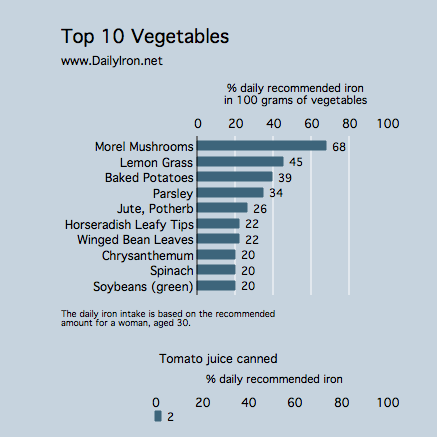Tomato juice contains .43 milligrams of iron per 100 grams. Grams is a measure of weight. To put 100 grams in perspective, consider alternative measures for this food:
- 1 cup equals 243 grams.
- 1 fl oz equals 30 grams.
In the category of vegetables, we included whole vegetable products in the Top 10 list. We excluded dried/dehydrated products from the Top 10. You will find some dehydrated vegetables high in iron per 100 grbut they tend to be far more volume than anyone would consume. Furthermore, foods may be fortified with iron but are not included in this Top 10 list. The food tested for the particular graph below can be described more specifically as:
Tomato juice, canned, without salt added
Read more about iron in vegetables or visit our iron-rich foods list.

Vegetables typically are not a good source of iron. Those vegetables that are loaded with iron also are likely to be packed with substances that inhibit iron — you may not take in a large amount of iron from the vegetables.
However, even a vegetable with minimal iron can play a valuable part in iron metabolism. Vegetables can often be packed with vitamin C and vitamin C will actually help you metabolize the iron more completely in plant-based food items; tomato juice is a solid source of vitamin C.
For example, you can include bell peppers and vine ripened tomatoes with a grain-based main dish or with a bean-based dish to increase your absorption of the iron in your whole meal. A raw kiwi treat with a meal would also help because of the fruit’s content of vitamin C. A glass of fruit juice is also an effective move.